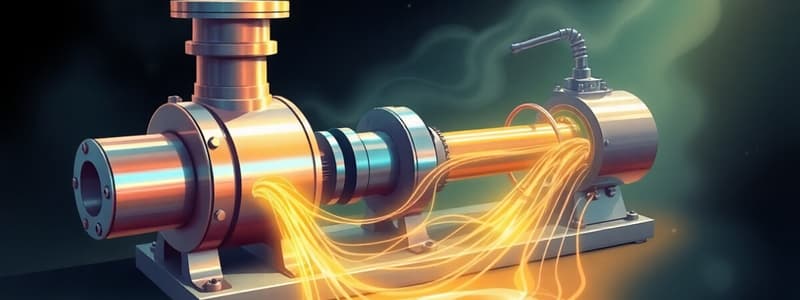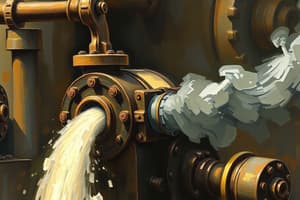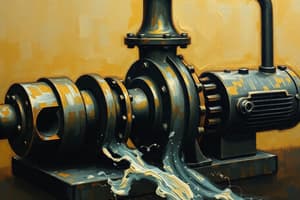Podcast
Questions and Answers
What is the purpose of priming a pump?
What is the purpose of priming a pump?
- To fill the pump chamber with liquid before operation (correct)
- To measure the pressure difference across the pump
- To create a continuous flow of liquid
- To increase the temperature of the pump
What phenomenon can occur due to vapour bubbles bursting inside a pump?
What phenomenon can occur due to vapour bubbles bursting inside a pump?
- Increased efficiency of the pump
- Cavitation, causing pump damage (correct)
- Reduced pressure difference
- Continuous flow improvement
What does throttling refer to in pump operations?
What does throttling refer to in pump operations?
- Completely opening the discharge valve
- Increasing the pressure difference across the pump
- Slowly closing the discharge valve to decrease flow (correct)
- Operating a pump under no load
What can deadheading a pump potentially cause?
What can deadheading a pump potentially cause?
What is meant by differential pressure in the context of pumps?
What is meant by differential pressure in the context of pumps?
Which type of pump is primarily designed to deliver a fixed quantity with each stroke or cycle?
Which type of pump is primarily designed to deliver a fixed quantity with each stroke or cycle?
What factor primarily governs the selection of a pump type for transferring sensitive products?
What factor primarily governs the selection of a pump type for transferring sensitive products?
Which property of a food product like mayonnaise changes as shear rate increases?
Which property of a food product like mayonnaise changes as shear rate increases?
Why is hot water particularly challenging to pump?
Why is hot water particularly challenging to pump?
Which of the following is NOT a type of positive displacement pump?
Which of the following is NOT a type of positive displacement pump?
What is the main mechanism by which centrifugal pumps deliver fluids?
What is the main mechanism by which centrifugal pumps deliver fluids?
What must be done before a centrifugal pump can operate effectively?
What must be done before a centrifugal pump can operate effectively?
What happens to the flow rate of a centrifugal pump when the outlet valve is adjusted?
What happens to the flow rate of a centrifugal pump when the outlet valve is adjusted?
Which type of liquids are centrifugal pumps best suited for?
Which type of liquids are centrifugal pumps best suited for?
What is a common limitation of centrifugal pumps regarding viscosity?
What is a common limitation of centrifugal pumps regarding viscosity?
During the operation of a centrifugal pump, what does the impeller do?
During the operation of a centrifugal pump, what does the impeller do?
What can happen if vapor bubbles form inside a centrifugal pump?
What can happen if vapor bubbles form inside a centrifugal pump?
Why is it essential to keep the inlet valve of a centrifugal pump open once it is primed?
Why is it essential to keep the inlet valve of a centrifugal pump open once it is primed?
What is the primary component that allows rotary pumps to function effectively in pumping viscous fluids?
What is the primary component that allows rotary pumps to function effectively in pumping viscous fluids?
Which characteristic distinguishes a rotary gear pump from other pump types?
Which characteristic distinguishes a rotary gear pump from other pump types?
What happens to the liquid in a rotary gear pump as the rotors turn?
What happens to the liquid in a rotary gear pump as the rotors turn?
What is one limitation of rotary pumps regarding the types of liquids they can effectively handle?
What is one limitation of rotary pumps regarding the types of liquids they can effectively handle?
Why do rotary gear pumps experience fewer problems with cavitation?
Why do rotary gear pumps experience fewer problems with cavitation?
In what type of applications are rotary gear pumps particularly useful due to their generated pressures?
In what type of applications are rotary gear pumps particularly useful due to their generated pressures?
Which of the following types of rotary pumps utilizes semi-interlocking mechanisms?
Which of the following types of rotary pumps utilizes semi-interlocking mechanisms?
What is a notable advantage of rotary pumps over reciprocating pumps in terms of flow?
What is a notable advantage of rotary pumps over reciprocating pumps in terms of flow?
What is the primary function of a peristaltic pump?
What is the primary function of a peristaltic pump?
Which of the following is an advantage of using peristaltic pumps?
Which of the following is an advantage of using peristaltic pumps?
In what scenario are peristaltic pumps particularly beneficial?
In what scenario are peristaltic pumps particularly beneficial?
How does the compression process in a peristaltic pump affect the fluid?
How does the compression process in a peristaltic pump affect the fluid?
Why are peristaltic pumps considered easy to clean and sterilize?
Why are peristaltic pumps considered easy to clean and sterilize?
What characteristic of peristaltic pumps contributes to their lower cost of maintenance?
What characteristic of peristaltic pumps contributes to their lower cost of maintenance?
What type of rotor forms are available for rotary lobe pumps?
What type of rotor forms are available for rotary lobe pumps?
How is fluid flow induced in a peristaltic pump during operation?
How is fluid flow induced in a peristaltic pump during operation?
What is a primary characteristic of a piston pump's operation?
What is a primary characteristic of a piston pump's operation?
What type of flow is typically produced by a piston pump?
What type of flow is typically produced by a piston pump?
What distinguishes a diaphragm pump from a piston pump?
What distinguishes a diaphragm pump from a piston pump?
Why is the choice of diaphragm material important in diaphragm pumps?
Why is the choice of diaphragm material important in diaphragm pumps?
How can pulsed flow be mitigated when using reciprocating pumps?
How can pulsed flow be mitigated when using reciprocating pumps?
In which industry are diaphragm pumps frequently used, and why?
In which industry are diaphragm pumps frequently used, and why?
What is a key advantage of using reciprocating pumps?
What is a key advantage of using reciprocating pumps?
Which feature of diaphragm pumps minimizes the risk of pump corrosion?
Which feature of diaphragm pumps minimizes the risk of pump corrosion?
What is one major advantage of using a double-acting diaphragm pump over a single-acting one?
What is one major advantage of using a double-acting diaphragm pump over a single-acting one?
Why might pulsed flow be undesirable in certain applications?
Why might pulsed flow be undesirable in certain applications?
What is a common consequence if a reciprocating pump experiences deadheading?
What is a common consequence if a reciprocating pump experiences deadheading?
How do diaphragm pumps differ from piston pumps in the pharmaceutical industry?
How do diaphragm pumps differ from piston pumps in the pharmaceutical industry?
What characteristic of reciprocating pumps can make them less suitable for certain liquids?
What characteristic of reciprocating pumps can make them less suitable for certain liquids?
What is the operational principle of a single-acting diaphragm pump?
What is the operational principle of a single-acting diaphragm pump?
What type of liquids are reciprocating pumps typically unsuitable for?
What type of liquids are reciprocating pumps typically unsuitable for?
What happens during the initial suction stroke in a diaphragm pump?
What happens during the initial suction stroke in a diaphragm pump?
In what context are safety relief valves particularly important in reciprocating pumps?
In what context are safety relief valves particularly important in reciprocating pumps?
What is one effective method to prevent the dangerous build-up of static electricity in pumps?
What is one effective method to prevent the dangerous build-up of static electricity in pumps?
Which of the following should an operator report immediately when observing unusual signs from a working pump?
Which of the following should an operator report immediately when observing unusual signs from a working pump?
What consequence can occur if operators do not follow specified operational procedures for pumps?
What consequence can occur if operators do not follow specified operational procedures for pumps?
Why is it critical to choose the correct type of pump for a specific operation?
Why is it critical to choose the correct type of pump for a specific operation?
Which scenario is most likely to pose a risk of static electricity in a pumping system?
Which scenario is most likely to pose a risk of static electricity in a pumping system?
Flashcards
Pump Priming
Pump Priming
Filling a pump chamber with liquid before operation.
Pulsed Flow
Pulsed Flow
Pumping liquid in short, repeated bursts.
Cavitation
Cavitation
Pump damage caused by vapour bubbles bursting.
Differential Pressure
Differential Pressure
Signup and view all the flashcards
Deadheading a pump
Deadheading a pump
Signup and view all the flashcards
What governs the pump type?
What governs the pump type?
Signup and view all the flashcards
Shear Sensitive Products
Shear Sensitive Products
Signup and view all the flashcards
Viscosity and Shear Rate
Viscosity and Shear Rate
Signup and view all the flashcards
Centrifugal Pumps
Centrifugal Pumps
Signup and view all the flashcards
Positive Displacement Pumps
Positive Displacement Pumps
Signup and view all the flashcards
Priming a Centrifugal Pump
Priming a Centrifugal Pump
Signup and view all the flashcards
High Flow Rate
High Flow Rate
Signup and view all the flashcards
Viscous Liquids
Viscous Liquids
Signup and view all the flashcards
What affects a centrifugal pump's efficiency?
What affects a centrifugal pump's efficiency?
Signup and view all the flashcards
Why is priming a centrifugal pump important?
Why is priming a centrifugal pump important?
Signup and view all the flashcards
Centrifugal Pump Application
Centrifugal Pump Application
Signup and view all the flashcards
Rotary Pump
Rotary Pump
Signup and view all the flashcards
Rotary Pump Advantages
Rotary Pump Advantages
Signup and view all the flashcards
Gear Pump Operation
Gear Pump Operation
Signup and view all the flashcards
Rotary Pump Priming
Rotary Pump Priming
Signup and view all the flashcards
Rotary Pump Flow
Rotary Pump Flow
Signup and view all the flashcards
Rotary Pump Cavitation Issues
Rotary Pump Cavitation Issues
Signup and view all the flashcards
Limitations of Rotary Pumps
Limitations of Rotary Pumps
Signup and view all the flashcards
Rotary Pump Applications
Rotary Pump Applications
Signup and view all the flashcards
Rotary Lobe Pump
Rotary Lobe Pump
Signup and view all the flashcards
Peristaltic Pump
Peristaltic Pump
Signup and view all the flashcards
Peristaltic Pump Advantages
Peristaltic Pump Advantages
Signup and view all the flashcards
How does a Lobe Pump move fluid?
How does a Lobe Pump move fluid?
Signup and view all the flashcards
Why are Peristaltic pumps used for delicate fluids?
Why are Peristaltic pumps used for delicate fluids?
Signup and view all the flashcards
What is the key feature of a Peristaltic pump?
What is the key feature of a Peristaltic pump?
Signup and view all the flashcards
What are some applications of Peristaltic pumps?
What are some applications of Peristaltic pumps?
Signup and view all the flashcards
How is fluid moved in a Peristaltic pump?
How is fluid moved in a Peristaltic pump?
Signup and view all the flashcards
What are reciprocating pumps used for?
What are reciprocating pumps used for?
Signup and view all the flashcards
Types of Reciprocating Pumps
Types of Reciprocating Pumps
Signup and view all the flashcards
Piston Pump
Piston Pump
Signup and view all the flashcards
Diaphragm Pump
Diaphragm Pump
Signup and view all the flashcards
What is a pulsed flow?
What is a pulsed flow?
Signup and view all the flashcards
How to achieve a more even flow?
How to achieve a more even flow?
Signup and view all the flashcards
What is the advantage of a diaphragm pump?
What is the advantage of a diaphragm pump?
Signup and view all the flashcards
How does a diaphragm pump work?
How does a diaphragm pump work?
Signup and view all the flashcards
Diaphragm Pump Action
Diaphragm Pump Action
Signup and view all the flashcards
Single-Acting Diaphragm Pump
Single-Acting Diaphragm Pump
Signup and view all the flashcards
Double-Acting Diaphragm Pump
Double-Acting Diaphragm Pump
Signup and view all the flashcards
Flow Rate in Reciprocating Pumps
Flow Rate in Reciprocating Pumps
Signup and view all the flashcards
Cavitation in Diaphragm Pumps
Cavitation in Diaphragm Pumps
Signup and view all the flashcards
Diaphragm Pump Portability
Diaphragm Pump Portability
Signup and view all the flashcards
Diaphragm Pumps in Pharmaceuticals
Diaphragm Pumps in Pharmaceuticals
Signup and view all the flashcards
Reciprocating Pump Maintenance
Reciprocating Pump Maintenance
Signup and view all the flashcards
Static Electricity in Pipelines
Static Electricity in Pipelines
Signup and view all the flashcards
Earthing Pumps and Pipelines
Earthing Pumps and Pipelines
Signup and view all the flashcards
Operator Alert Signs
Operator Alert Signs
Signup and view all the flashcards
Following Operational Procedures
Following Operational Procedures
Signup and view all the flashcards
Why Are Different Pumps Used?
Why Are Different Pumps Used?
Signup and view all the flashcards
Study Notes
Pump Priming
- Priming is necessary for some pumps.
- It involves filling the pump chamber with the liquid before operation.
- Priming replaces air with liquid in the pump's chamber.
- Incorrect priming can prevent some pumps from working.
Pump Flow Characteristics
- Pulsed flow: pump liquid flow that stops and starts periodically.
- Vapour bubbles: liquids pumped at low pressure can create vapour bubbles.
- Cavitation: bursting vapour bubbles inside the pump can cause significant damage.
Pump Pressure and Flow Control
- Differential pressure: the pressure difference across a pump drives the liquid flow.
- Throttling: slowly closing a valve on a pump's discharge reduces flow.
- Dead-heading: operating a pump with the discharge valve fully closed.
- Dead-heading can damage some pumps or cause piping failures.
Studying That Suits You
Use AI to generate personalized quizzes and flashcards to suit your learning preferences.
Description
This quiz explores the essential principles of pump operation, including priming, flow characteristics, and pressure control methods. Understand the importance of proper priming and the impact of various flow dynamics on pump performance. Test your knowledge on how different conditions can affect pump functionality.




